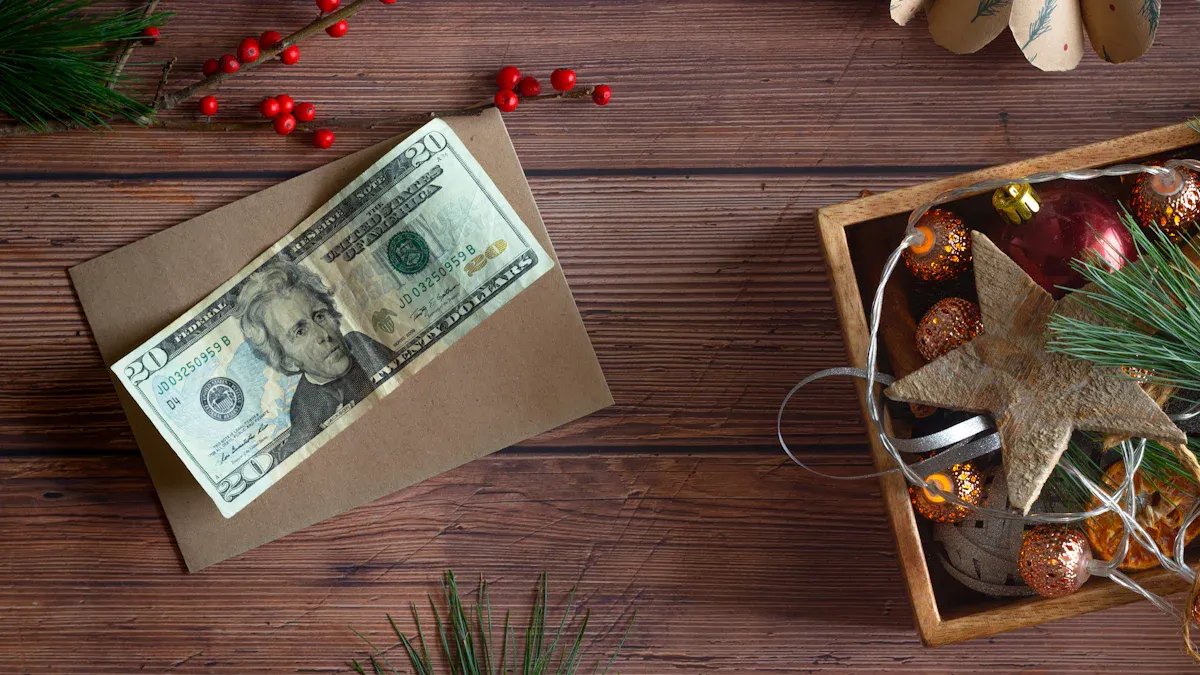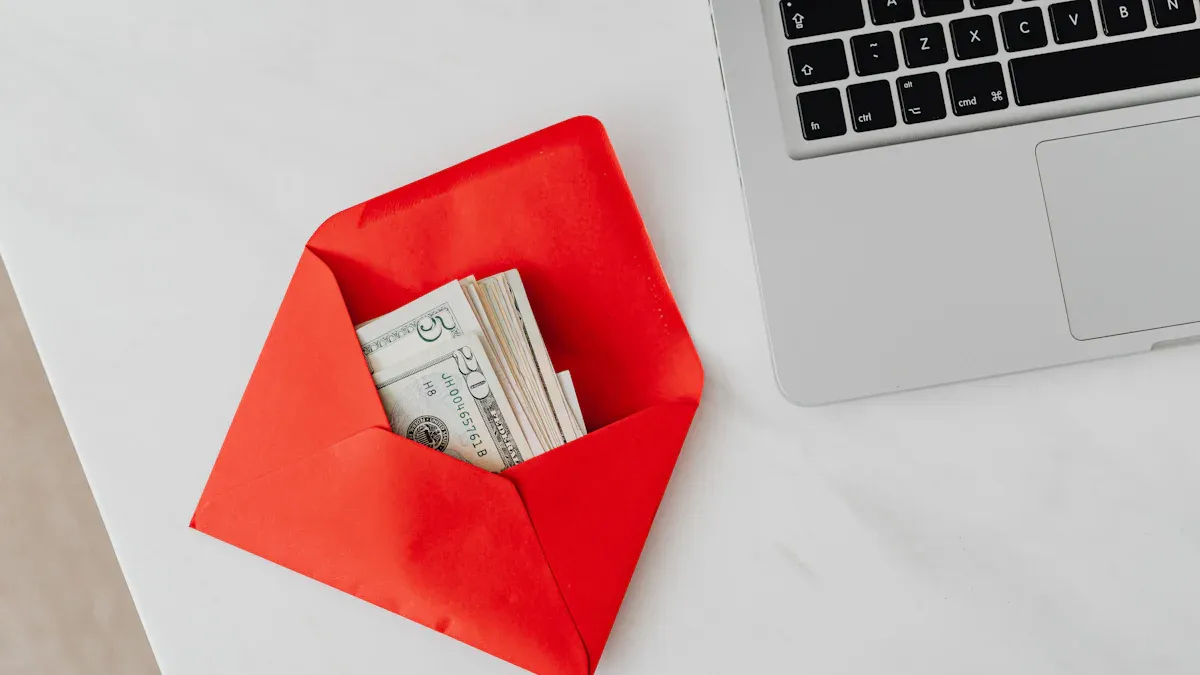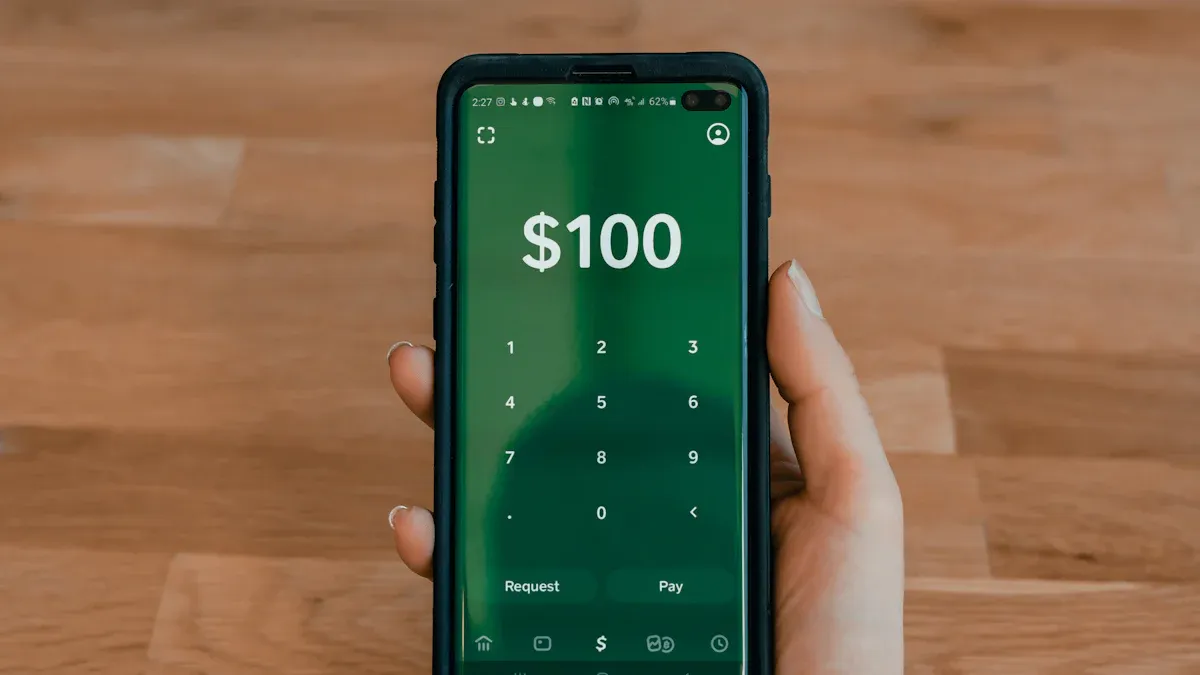- EasyCard
- Trade
- Help
- Announcement
- Academy
- SWIFT Code
- Iban Number
- Referral
- Customer Service
- Blog
- Creator
Is it safe to send money by mail? Remittance methods, fees, and safety guidelines

Image Source: unsplash
Directly mailing cash is a highly unsafe and unrecommended practice. While mailing cash is risky, you still have safer postal-based remittance options, such as money orders.
According to SafeWise, 31% of people experienced package theft in the past year, with an average loss of $143. Mail theft and related fraud are becoming increasingly common.
Key Points
- Mailing cash is highly unsafe, as mail can be lost, stolen, or damaged, with little chance of tracking or compensation.
- Money orders and cashier’s checks are safer traditional transfer methods with traceable records, but beware of check fraud.
- Electronic transfers, bank wires, and online remittance services are modern, safer options with fast delivery and robust security.
- When choosing a transfer method, consider cost, speed, and safety, and always verify recipient information and keep transaction receipts.
- Even small amounts of cash should not be mailed due to high risks and difficulty obtaining compensation if lost.
Inherent Risks of Mailing Cash

Image Source: pexels
Stuffing cash into an envelope and dropping it in a mailbox may seem simple and direct, but this action hides significant risks. Once the envelope leaves your sight, you lose all control over the money. Let’s explore why mailing cash is a bad idea you should avoid at all costs.
Mail Loss and Damage
Your letter undergoes a long, complex journey before reaching the recipient. It passes through high-speed sorting machines, trucks, or even planes, handled by multiple postal workers. At any point, accidents can happen.
- Physical Damage: Envelopes may tear in sorting equipment, causing cash to fall out.
- Accidental Loss: Letters may be mis-sorted to wrong addresses or slip from damaged mailbags during transport.
- Environmental Factors: Harsh weather like rain or snow can wet envelopes, causing damage or illegible addresses, preventing delivery.
If these occur, the cash in the envelope is likely lost forever.
Theft Risks During Processing
Mail theft is a growing problem. For thieves, a plain envelope is a potential target, and cash is their favorite prey because it’s untraceable.
Thieves use various methods, striking at nearly every stage of mail delivery:
- Directly stealing from your home mailbox or apartment building’s central mailbox.
- Using specialized tools to “fish” letters from community blue postal collection boxes.
- Seizing opportunities at sorting centers or during transport.
More concerning, organized crime groups have industrialized mail theft. They not only steal cash but also checks, using chemicals to “wash” information and rewrite payees and amounts. If they can perform such sophisticated check fraud, stealing untraceable cash is effortless.
Lack of Effective Tracking and Compensation
When you mail cash, you relinquish nearly all recourse. Unlike bank transfers or money orders, mailing cash leaves no transaction record.
Important Note: Minimal Compensation Even with tracking services, you can’t prove cash was in the envelope. If mail is lost, compensation is nearly impossible. For example, with the U.S. Postal Service (USPS), the maximum compensation for cash sent via regular mail without insurance is just $15—regardless of how much you sent.
This means if you mailed $500 and it’s lost, you’d receive at most $15 in symbolic compensation, bearing the significant loss yourself.
Violating Postal Regulations
While mailing small amounts of cash isn’t necessarily illegal, many postal systems have strict rules to deter this risky practice. Non-compliance may result in mail rejection or lack of protection.
For example, the U.S. Postal Service (USPS) explicitly advises customers not to send cash through the mail. They have specific regulations:
- Registered Mail Requirement: Mailing over $500 in cash for commercial purposes requires Registered Mail service.
- Insurance Limits: Only with Registered Mail can cash be insured up to $50,000. For all other mail services, the insurance cap for cash is the negligible $15.
- Packaging Restrictions: Free express packaging from post offices cannot be used for commercial cash transactions.
These rules clearly show that postal services view mailing cash as irregular and risky, setting thresholds to guide you toward safer methods.
Safe Traditional Transfer Methods
Since mailing cash is so risky, what are safer postal-based alternatives? Fortunately, some traditional methods remain reliable. Their core advantage is traceability and designated payee, starkly contrasting untraceable cash. Let’s explore three main traditional tools.
Money Order
Money orders are highly reliable, like prepaid, guaranteed checks. Since you pay the full amount upfront, recipients can cash them confidently without worrying about bounced checks. They’re ideal for those without bank accounts.
How to Purchase and Send a Money Order?
The process is straightforward. Using the U.S. Postal Service (USPS) as an example, follow these steps:
- Purchase: Buy a money order at any post office branch.
- Fill Out Information: This is critical for your funds’ safety.
- In the “Pay to” field, immediately write the recipient’s name to prevent theft if lost. Ensure the name is spelled correctly.
- Fill in your name and address in the “From” field.
- Sign the front to make it valid. Do not sign the back, which is for the recipient to cash.
- Pay Fees: Use cash, debit card, or traveler’s checks to cover the money order amount and a small handling fee.
- Mail Securely: Place the completed money order in an envelope and mail it to the recipient.
- Keep Receipt: Store the purchase receipt safely. It’s your only proof for tracking or replacing a lost or damaged money order.
Safety Tip: The biggest advantage of money orders is the designated payee. Even if stolen, thieves can’t easily cash them.
Personal Check
Personal checks are another common cash alternative. They draw funds directly from your bank account and can designate a payee, offering greater safety than cash.
However, checks aren’t risk-free. Check-related fraud has surged. Criminals steal checks from mailboxes, use chemicals to “wash” information, and rewrite payees and amounts.
Alarming Data: According to the Financial Crimes Enforcement Network (FinCEN), check fraud related to mail theft exceeded $688 million in the first six months of 2023 alone. Experts predict global check fraud losses may exceed $24 billion in 2024. This shows that even with checks, vigilance is needed.
Despite risks, checks’ traceability is a major advantage. If a check is lost or stolen, you can act quickly.
How to Handle a Lost or Stolen Check?
- Check Status: Log into online banking or contact your bank to confirm the check hasn’t been cashed.
- Gather Information: Prepare your checking account number, lost check number, payee name, amount, and issue date.
- Request a Stop Payment: Contact your bank (e.g., licensed Hong Kong banks often offer online or phone services) to stop payment. The bank flags the check, preventing cashing. This service typically costs $15 to $35.
Cashier’s Check
Cashier’s checks are considered safer than personal checks, especially for large transactions. Issued by banks, funds are drawn from the bank’s account, not yours, backed by the bank’s credit, ensuring recipient trust.
However, criminals have learned to forge convincing cashier’s checks, often used in sophisticated scams.
- Overpayment Scams: In online transactions, scammers send a cashier’s check exceeding the item’s price, then ask you to wire back the excess. After you send real money, the bank discovers the check is fake, leaving you with the loss.
- Secret Shopper Scams: You’re “hired” as a secret shopper, receive a cashier’s check, and are instructed to evaluate a service (e.g., a money transfer company) and send the rest to the “employer.” The check is later found fake, and you’re liable for the spent and sent money.
- Rental Scams: A “tenant” sends a cashier’s check for deposit and rent but cancels the lease for various reasons, asking for a partial refund. After you refund, the check is revealed as fake.
How to Protect Against Fake Cashier’s Check Scams?
- Verify Source: Be highly skeptical of cashier’s checks from strangers.
- Independent Verification: Don’t use the phone number on the check to contact the bank. Find the issuing bank’s contact info independently via its official website and verify the check’s authenticity.
- Wait for Clearance: Before using the funds, confirm with your bank that the check has not only been deposited but “fully cleared,” which may take days or longer.
In summary, while these traditional tools are far safer than cash, you must remain cautious and take precautions to protect your funds.
Modern Electronic Transfers: A Better Choice

Image Source: unsplash
In the digital age, abandoning mailed cash and checks for electronic transfers is wiser. Electronic methods are faster and offer robust security through encryption and fraud protection, unmatched by traditional mailing.
Convenience of Electronic Transfers
Electronic transfers (E-transfers) let you move funds from one bank account to another via online banking or mobile apps. They’re nearly instant, ideal for sending money to family or friends.
To protect your funds and information, banks and payment systems use multiple security measures, building a strong defense for safe transactions.
- SSL/eIDAS Certificates: Ensure you’re accessing a legitimate bank website and encrypt data during transmission.
- PGP Keys: Add an extra encryption layer for payment instructions, preventing theft or tampering during transfer.
- 3SKeys: Use unique electronic signatures to verify transaction authenticity, ensuring only you can authorize transfers.
Friendly Tip: Electronic transfer services often have daily or weekly transfer limits. For example, services like Zelle and Interac have bank-specific limits. Check your online banking for current transfer limits before large transactions.
Reliability of Bank Wire Transfers
For large or critical international transfers, bank wire transfers are highly reliable. Handled directly by banks, funds move securely within the banking system. You can initiate wires through licensed banks, such as those in Hong Kong.
Accurate recipient information is crucial for smooth delivery.
- Domestic U.S. Wire Transfer Information:
- Recipient’s full name and address
- Receiving bank name
- Recipient’s bank account and routing number
- International Wire Transfer Additional Information:
- SWIFT/BIC Code: International standard code identifying the recipient bank.
- IBAN Number: Used in some countries, especially Europe, for international bank accounts.
Online Remittance Services
Recently, online remittance platforms like Wise and PayPal have gained popularity, offering more convenient and cost-effective international transfer solutions than traditional banks.
These platforms are tightly regulated. In the US, they’re governed by laws like the Electronic Fund Transfer Act (EFTA), providing strong consumer protections. They invest heavily in user safety, including:
- Two-Factor Authentication (2FA): Adds an extra security layer to your account.
- 24/7 Transaction Monitoring: Dedicated anti-fraud teams monitor transactions to prevent fraud and identity theft.
- Transparent Rates: Unlike banks hiding fees in exchange rates, platforms like Wise use the mid-market rate, charging only a clear, small service fee, saving you money on conversions.
Before choosing any method, carefully compare speed, fees, and security features to select the best option for your needs.
Cost and Timeline Comparison of Methods
When choosing a transfer method, cost and speed are key considerations. Different methods vary significantly in fees and delivery times. Understanding these helps you make the most economical and efficient choice.
Traditional Mailing Method Costs
Traditional tools have relatively low fees but require balancing convenience and safety.
- Money Order: An affordable option. Fees vary by issuer and amount. For example, USPS fees are:
Fee Maximum Amount $2.10 $500 $3.00 $1,000 $0.75 All money orders issued via military facilities Private companies like Western Union may charge between $1 and $2, depending on location. - Cashier’s Check: Typically costlier than money orders. For bank customers, issuing a cashier’s check costs about $10 to $15. For example, Wells Fargo charges $10 for account holders. Non-customers may pay more.
Electronic Transfer Method Costs
Electronic transfers are faster but have varied fee structures, especially for international transactions.
- Bank Wire Transfer: Fees are relatively high but reliable. Domestic wire fees for major U.S. banks include:
Bank Domestic Outgoing Fee Range Chase $25–$35 Bank of America $30 Industry Average $27 Important Note: International wire fees are typically higher, ranging from $35 to $50. Professional online remittance companies often offer better fees and rates.
Delivery Time Comparison
Time is another key difference. Electronic methods are almost always faster than mailing.
- Mailing Methods: Mailing a check or money order takes days to arrive. The recipient then needs to deposit it at a bank, with full clearance taking additional business days, potentially a week or more.
- Electronic Methods: Much faster.
- Services like Zelle are nearly instant.
- Domestic bank wires typically arrive within the same business day.
- International wires take 1 to 5 business days, depending on destination, time zones, and bank processing. Transfers to major financial hubs like the UK or Canada often complete in 1-2 days.
In summary, if you prioritize low cost and don’t mind time, traditional methods may work. For fast, secure transfers, electronic options are superior.
Step-by-Step Safe Transfer Guide
Regardless of your chosen method, following a standard safety process is critical to protect your funds and avoid losses. Here’s a simple four-step guide to ensure safe transfers.
Step 1: Choose the Right Tool
Your first task is selecting the most suitable tool based on your needs. Review the methods discussed:
- For speed and convenience, electronic transfers or online remittance services are best.
- For mailing with assurance, money orders or cashier’s checks are far safer than cash.
Clarify your priorities—cost, speed, or safety—to make an informed decision.
Step 2: Verify Recipient Information
This is the most error-prone and critical step. Incorrect information can lead to lost funds or transfers to the wrong person. Before initiating any transfer, verify all details carefully.
Safety Checklist:
- Direct Communication Verification: Call the recipient via a trusted phone number to confirm their full name, address, and bank account details. Avoid relying solely on email or texts, which may be hacked.
- Watch for Info Changes: If the recipient suddenly requests a change in details, verify via a reliable method like a phone call.
- Avoid Emailing Sensitive Info: Don’t send full account or routing numbers via regular email. Use encrypted email if necessary.
Step 3: Use Trackable Mailing
If mailing a money order or check, never use regular mail. Choose services with tracking for added protection.
For example, USPS’s Certified Mail service is a good choice. Its base fee is about $5.30 (excluding postage), providing proof of mailing and requiring recipient signature. You can track delivery status online. Though it costs extra, it’s worth it compared to the risk of losing funds.
Step 4: Keep All Receipts
Your work isn’t done after the transaction. Always keep all related documents.
- For money orders or cashier’s checks, save the purchase receipt.
- For electronic transfers or wires, save the transaction confirmation number or screenshot.
These receipts are your “lifeline.” If issues arise, like a lost money order or delayed transfer, they’re your only evidence for inquiries, tracking, or claims with banks or post offices.
Mailing cash is extremely risky and should be avoided. Choosing safer methods is crucial. For traditional options, money orders and cashier’s checks are reliable. In modern times, electronic transfers and online services are more efficient and secure. Regardless of the method, protecting personal information and keeping transaction receipts are key to safeguarding funds.
For more on financial fraud, refer to resources from:
- Consumer Financial Protection Bureau (CFPB)
- Federal Trade Commission (FTC)
- U.S. Department of Justice (DOJ)
- Federal Deposit Insurance Corporation (FDIC)
FAQ
Can I mail a small amount of cash for emergencies?
Even small amounts carry high risks. Letters can be lost, stolen, or damaged in transit. If an accident occurs, compensation is nearly impossible. Avoid mailing any cash.
What if my mailed money order is lost?
Don’t worry, your funds are safe.
Contact the issuing institution (e.g., post office) immediately with your purchase receipt. They can help track the money order and issue a replacement or refund if confirmed lost. This highlights the importance of keeping receipts.
How do I ensure recipient information is correct for electronic transfers?
The best practice is to verify information directly with the recipient via a phone call. Confirm their full name, bank account, and routing number verbally. Don’t rely solely on potentially compromised emails or texts.
Which transfer method is the cheapest?
- Money Order: Often the lowest cost, with fees of a few dollars.
- Cashier’s Check: Slightly higher, around $10-$15.
- Bank Wire Transfer: Most expensive, especially for international wires.
Balance cost and speed based on your needs.
*This article is provided for general information purposes and does not constitute legal, tax or other professional advice from BiyaPay or its subsidiaries and its affiliates, and it is not intended as a substitute for obtaining advice from a financial advisor or any other professional.
We make no representations, warranties or warranties, express or implied, as to the accuracy, completeness or timeliness of the contents of this publication.




Contact Us
Company and Team
BiyaPay Products
Customer Services
is a broker-dealer registered with the U.S. Securities and Exchange Commission (SEC) (No.: 802-127417), member of the Financial Industry Regulatory Authority (FINRA) (CRD: 325027), member of the Securities Investor Protection Corporation (SIPC), and regulated by FINRA and SEC.
registered with the US Financial Crimes Enforcement Network (FinCEN), as a Money Services Business (MSB), registration number: 31000218637349, and regulated by FinCEN.
registered as Financial Service Provider (FSP number: FSP1007221) in New Zealand, and is a member of the Financial Dispute Resolution Scheme, a New Zealand independent dispute resolution service provider.



















